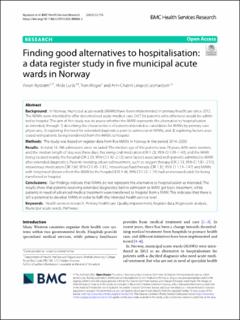| dc.contributor.author | Nystrøm, Vivian | |
| dc.contributor.author | Lurås, Hilde | |
| dc.contributor.author | Moger, Tron | |
| dc.contributor.author | Leonardsen, Ann-Chatrin Linqvist | |
| dc.date.accessioned | 2022-12-14T10:43:45Z | |
| dc.date.available | 2022-12-14T10:43:45Z | |
| dc.date.created | 2022-05-30T17:54:59Z | |
| dc.date.issued | 2022 | |
| dc.identifier.citation | BMC Health Services Research. 2022, 22, Artikkel 715. | en_US |
| dc.identifier.issn | 1472-6963 | |
| dc.identifier.uri | https://hdl.handle.net/11250/3037663 | |
| dc.description.abstract | Background: In Norway, municipal acute wards (MAWs) have been implemented in primary healthcare since 2012. The MAWs were intended to ofer decentralised acute medical care 24/7 for patients who otherwise would be admit‑ted to hospital. The aim of this study was to assess whether the MAW represents the alternative to hospitalisation as intended, through 1) describing the characteristics of patients intended as candidates for MAWs by primary care physicians, 2) exploring the need for extended diagnostics prior to admission in MAWs, and 3) exploring factors associated with patients being transferred from the MAWs to hospital.
Methods: The study was based on register data from fve MAWs in Norway in the period 2014–2020.
Results: In total, 16 786 admissions were included. The median age of the patients was 78 years, 60% were women, and the median length of stay was three days. Receiving oral medication (OR 1.23, 95% CI 1.09–1.40), and the MAW being located nearby the hospital (OR 2.29, 95% CI 1.92–2.72) were factors associated with patients admitted to MAW after extended diagnostics. Patients needing advanced treatment, such as oxygen therapy (OR 2.13, 95% CI 1.81–2.51), intravenous medication (OR 1.60, 95% CI 1.45–1.81), intravenous fuid therapy (OR 1.32, 95% CI 1.19–1.47) and MAWs with long travel distance from the MAW to the hospital (OR 1.46, 95% CI 1.22–1.74) had an increased odds for being transferred to hospital.
Conclusions: Our fndings indicate that MAWs do not represent the alternative to hospitalisation as intended. The results show that patients receiving extended diagnostics before admission to MAW got basic treatment, while patients in need of advanced medical treatment were transferred to hospital from a MAW. This indicates that there is still a potential to develop MAWs in order to fulfl the intended health service level. | en_US |
| dc.language.iso | eng | en_US |
| dc.publisher | BioMed Central (BMC) | en_US |
| dc.rights | Navngivelse 4.0 Internasjonal | * |
| dc.rights.uri | http://creativecommons.org/licenses/by/4.0/deed.no | * |
| dc.subject | health services research | en_US |
| dc.subject | primary healthcare | en_US |
| dc.subject | quality improvement | en_US |
| dc.subject | register data | en_US |
| dc.subject | regression analysis | en_US |
| dc.subject | municipal acute wards | en_US |
| dc.subject | pathways | en_US |
| dc.title | Finding good alternatives to hospitalisation: a data register study in five municipal acute wards in Norway | en_US |
| dc.type | Peer reviewed | en_US |
| dc.type | Journal article | en_US |
| dc.description.version | publishedVersion | en_US |
| dc.rights.holder | © The Author(s) 2022. | en_US |
| dc.subject.nsi | VDP::Medisinske Fag: 700::Helsefag: 800::Helsetjeneste- og helseadministrasjonsforskning: 806 | en_US |
| dc.source.volume | 22 | en_US |
| dc.source.journal | BMC Health Services Research | en_US |
| dc.identifier.doi | 10.1186/s12913-022-08066-3 | |
| dc.identifier.cristin | 2028232 | |
| dc.source.articlenumber | 715 | en_US |
| cristin.ispublished | true | |
| cristin.fulltext | original | |
| cristin.qualitycode | 2 | |

